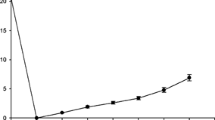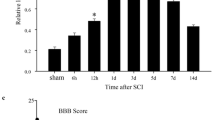Abstract
The Forkhead box M1 (FoxM1) protein is a proliferation-associated transcription factor that plays a key role in controlling both the G1/S and G2/M transitions of the cell cycle and regulates transcription of cell cycle genes, including cyclin-dependent kinase inhibitors p27(kip1) and p21(waf1/cip1). The expression levels of FoxM1 directly correlated with the proliferation index, cancer survival, genomic instability rate, and microvessel density, and inversely correlated with apoptosis. Furthermore, FoxM1 is determined to play a role in tissue repair following injury in the lungs and liver. However, the signaling of FoxM1, involved in its expression and its role in central nervous system lesion and repair is poorly known. In this study, we performed a spinal cord injury (SCI) model in adult Sprague–Dawley rats and investigated the dynamic changes and role of FoxM1 expression in the spinal cord. Western blot analysis revealed that FoxM1 was lowly presented in normal spinal cord. It gradually increased, reached a peak at day 3, and then declined to basal levels at 14 days after spinal cord injury. Immunohistochemistry further confirmed that FoxM1 was expressed at low levels in gray and white matters in normal condition and increased after SCI. Double immunofluorescence staining showed that FoxM1was co-expressed with NeuN (neuronal marker) and GFAP (astrocytic marker), and FoxM1 expression was increased predominantly in astrocytes after injury, which were regenerating axons and largely proliferated after injury. Furthermore, co-immunoprecipitation studies demonstrated increased interactions among FoxM1, Skp2, and p27kip1 in the spinal cord after injury. Taken together, these results provide new insights into the molecular mechanisms underlying astrocyte proliferation during SCI and suggest that FoxM1 might play crucial roles in CNS pathophysiology after SCI.





Similar content being viewed by others
References
Carrano AC, Eytan E, Hershko A, Pagano M (1999) SKP2 is required for ubiquitin-mediated degradation of the CDK inhibitor p27. Nat Cell Biol 1:193–199
Choi DC, Lee JY, Moon YJ, Kim SW, Oh TH, Yune TY (2010) Acupuncture-mediated inhibition of inflammation facilitates significant functional recovery after spinal cord injury. Neurobiol Dis 39:272–282
Coats S, Flanagan WM, Nourse J, Roberts JM (1996) Requirement of p27Kip1 for restriction point control of the fibroblast cell cycle. Science 272:877–880
Davies SJ, Field PM, Raisman G (1996) Regeneration of cut adult axons fails even in the presence of continuous aligned glial pathways. Exp Neurol 142:203–216
Dumont RJ, Okonkwo DO, Verma S, Hurlbert RJ, Boulos PT, Ellegala DB, Dumont AS (2001) Acute spinal cord injury, part I: pathophysiologic mechanisms. Clin Neuropharmacol 24:254–264
Fillies T, Woltering M, Brandt B, Van Diest JP, Werkmeister R, Joos U, Buerger H (2007) Cell cycle regulating proteins p21 and p27 in prognosis of oral squamous cell carcinomas. Oncol Rep 17:355–359
Gruner JA (1992) A monitored contusion model of spinal cord injury in the rat. J Neurotrauma 9:123–126, discussion 126–128
Herrmann JE, Imura T, Song B et al (2008) STAT3 is a critical regulator of astrogliosis and scar formation after spinal cord injury. J Neurosci 28:7231–7243
Kalin TV, Wang IC, Ackerson TJ et al (2006) Increased levels of the FoxM1 transcription factor accelerate development and progression of prostate carcinomas in both TRAMP and LADY transgenic mice. Cancer Res 66:1712–1720
Karimi-Abdolrezaee S, Billakanti R (2012) Reactive astrogliosis after spinal cord injury-beneficial and detrimental effects. Mol Neurobiol 46:251–264
Katoh M (2004) Human FOX gene family (review). Int J Oncol 25:1495–1500
Kim IM, Ackerson T, Ramakrishna S et al (2006) The Forkhead Box m1 transcription factor stimulates the proliferation of tumor cells during development of lung cancer. Cancer Res 66:2153–2161
Koo CY, Muir KW, Lam EW (2012) FOXM1: From cancer initiation to progression and treatment. Biochim Biophys Acta 1819:28–37
Korver W, Roose J, Wilson A, Clevers H (1997) The winged-helix transcription factor Trident is expressed in actively dividing lymphocytes. Immunobiology 198:157–161
Kwon BK, Tetzlaff W, Grauer JN, Beiner J, Vaccaro AR (2004) Pathophysiology and pharmacologic treatment of acute spinal cord injury. Spine J 4:451–464
Laoukili J, Stahl M, Medema RH (2007) FoxM1: at the crossroads of ageing and cancer. Biochim Biophys Acta 1775:92–102
Laoukili J, Kooistra MR, Bras A et al (2005) FoxM1 is required for execution of the mitotic programme and chromosome stability. Nat Cell Biol 7:126–136
Le Lay J, Kaestner KH (2010) The Fox genes in the liver: from organogenesis to functional integration. Physiol Rev 90:1–22
Leung TW, Lin SS, Tsang AC et al (2001) Over-expression of FoxM1 stimulates cyclin B1 expression. FEBS Lett 507:59–66
McDonald JW, Sadowsky C (2002) Spinal-cord injury. Lancet 359:417–425
McGraw J, Hiebert GW, Steeves JD (2001) Modulating astrogliosis after neurotrauma. J Neurosci Res 63:109–115
Nakayama K, Ishida N, Shirane M et al (1996) Mice lacking p27(Kip1) display increased body size, multiple organ hyperplasia, retinal dysplasia, and pituitary tumors. Cell 85:707–720
Nieto-Sampedro M (1999) Neurite outgrowth inhibitors in gliotic tissue. Adv Exp Med Biol 468:207–224
Ridet JL, Malhotra SK, Privat A, Gage FH (1997) Reactive astrocytes: cellular and molecular cues to biological function. Trends Neurosci 20:570–577
Rudge JS, Silver J (1990) Inhibition of neurite outgrowth on astroglial scars in vitro. J Neurosci 10:3594–3603
Sekhon LH, Fehlings MG (2001) Epidemiology, demographics, and pathophysiology of acute spinal cord injury. Spine (Phila Pa 1976) 26:S2–S12
Shen A, Liu Y, Zhao J et al (2008) Temporal-spatial expressions of p27kip1 and its phosphorylation on Serine-10 after acute spinal cord injury in adult rat: implications for post-traumatic glial proliferation. Neurochem Int 52:1266–1275
Shi S, Cheng C, Zhao J, Chen M, Qin J, Gao S, Shen A (2007) Expression of p27kip1 and Skp2 in the adult spinal cord following sciatic nerve injury. J Mol Neurosci 32:64–71
Silver J, Miller JH (2004) Regeneration beyond the glial scar. Nat Rev Neurosci 5:146–156
Sutterluty H, Chatelain E, Marti A, Wirbelauer C, Senften M, Muller U, Krek W (1999) p45SKP2 promotes p27Kip1 degradation and induces S phase in quiescent cells. Nat Cell Biol 1:207–214
Wang IC, Chen YJ, Hughes D et al (2005) Forkhead box M1 regulates the transcriptional network of genes essential for mitotic progression and genes encoding the SCF (Skp2-Cks1) ubiquitin ligase. Mol Cell Biol 25:10875–10894
Wang IC, Meliton L, Ren X et al (2009) Deletion of Forkhead Box M1 transcription factor from respiratory epithelial cells inhibits pulmonary tumorigenesis. PLoS One 4:e6609
Wang X, Kiyokawa H, Dennewitz MB, Costa RH (2002) The Forkhead Box m1b transcription factor is essential for hepatocyte DNA replication and mitosis during mouse liver regeneration. Proc Natl Acad Sci U S A 99:16881–16886
White RE, Jakeman LB (2008) Don't fence me in: harnessing the beneficial roles of astrocytes for spinal cord repair. Restor Neurol Neurosci 26:197–214
White RE, McTigue DM, Jakeman LB (2010) Regional heterogeneity in astrocyte responses following contusive spinal cord injury in mice. J Comp Neurol 518:1370–1390
White RE, Rao M, Gensel JC, McTigue DM, Kaspar BK, Jakeman LB (2011) Transforming growth factor alpha transforms astrocytes to a growth-supportive phenotype after spinal cord injury. J Neurosci 31:15173–15187
Wierstra I, Alves J (2007) FOXM1, a typical proliferation-associated transcription factor. Biol Chem 388:1257–1274
Wonsey DR, Follettie MT (2005) Loss of the forkhead transcription factor FoxM1 causes centrosome amplification and mitotic catastrophe. Cancer Res 65:5181–5189
Wu J, Pajoohesh-Ganji A, Stoica BA, Dinizo M, Guanciale K, Faden AI (2012) Delayed expression of cell cycle proteins contributes to astroglial scar formation and chronic inflammation after rat spinal cord contusion. J Neuroinflammation 9:169
Ye H, Holterman AX, Yoo KW, Franks RR, Costa RH (1999) Premature expression of the winged helix transcription factor HFH-11B in regenerating mouse liver accelerates hepatocyte entry into S phase. Mol Cell Biol 19:8570–8580
Yin X, Yin Y, Cao FL et al (2012) Tanshinone IIA attenuates the inflammatory response and apoptosis after traumatic injury of the spinal cord in adult rats. PLoS One 7:e38381
Yoshida Y, Wang IC, Yoder HM, Davidson NO, Costa RH (2007) The forkhead box M1 transcription factor contributes to the development and growth of mouse colorectal cancer. Gastroenterology 132:1420–1431
Young W (1993) Secondary injury mechanisms in acute spinal cord injury. J Emerg Med 11(Suppl 1):13–22
Zeng J, Wang L, Li Q, Li W, Bjorkholm M, Jia J, Xu D (2009) FoxM1 is up-regulated in gastric cancer and its inhibition leads to cellular senescence, partially dependent on p27 kip1. J Pathol 218:419–427
Zhang S, Huan W, Wei H et al (2012) FOXO3a/p27(kip1) expression and essential role after acute spinal cord injury in adult rat. J Cell Biochem 114:354–365
Zhao J, Zhang S, Wu X et al (2011) KPC1 expression and essential role after acute spinal cord injury in adult rat. Neurochem Res 36:549–558
Acknowledgments
This work was supported by the Natural Science Foundation of Zhejiang Province (no. Y2090545) and the key disciplines in Colleges and Universities of Zhejiang Province.
Author information
Authors and Affiliations
Corresponding author
Additional information
Shuangwei Zhang and Honglin Teng contributed equally to this work.
Rights and permissions
About this article
Cite this article
Zhang, S., Teng, H., Ding, Q. et al. FoxM1 Involvement in Astrocyte Proliferation after Spinal Cord Injury in Rats. J Mol Neurosci 51, 170–179 (2013). https://doi.org/10.1007/s12031-013-9972-0
Received:
Accepted:
Published:
Issue Date:
DOI: https://doi.org/10.1007/s12031-013-9972-0




